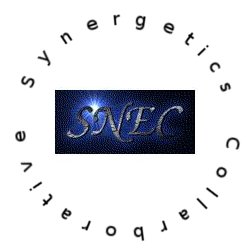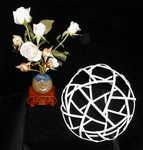|
101.01 Synergy means behavior of whole systems unpredicted by the behavior of their
parts taken separately.
102.00 Synergy means behavior of integral, aggregate, whole systems
unpredicted by behaviors of any of their components or subassemblies of their
components taken separately from the whole.
-- R. Buckminster Fuller, Synergetics, 1975
|

|
Synergetics, in the broadest terms, is the study of spatial complexity, and as
such is an inherently comprehensive discipline. ... Experience
with synergetics encourages a new way of approaching and solving problems.
Its emphasis on visual and spatial phenomena combined with Fuller's holistic
approach fosters the kind of lateral thinking which so often leads to creative
breakthroughs.
-- Amy Edmondson, A Fuller Explanation, 1987
|
SNEC Workshop on 28-29 June 2003 in Oswego, New York
Thank you to SUNY
Oswego, Department of Technology, Design Studio for hosting this,
the first, SNEC workshop!
Buckminster Fuller's Geodesic Structures
28-29 June 2003, Oswego, New York
This workshop provided an opportunity to build geodesics and explore
their geometries. After the SARS epidemic forced Yasushi Kajikawa
of Japan to abandon his trip leading the geodesic workshop, a new
program had to be developed quickly. Joe Clinton, Fuller's colleague
and protégé stepped in to create an educational hands-on
geodesic experience. Joe traveled to Oswego and spent three days in
the pre-planning, May 2-4. Professor John Belt graciously hosted the
event, using his incredible studio facility at SUNY Oswego, Department
of Technology with the help of his colleague Rich Bush (he also worked
and supervised the milling of rotegrity materials with Matt Fisher,
using Joe Clinton's jigs) and the enthusiastic participation of some of
his top design students.

On Friday's arrival we were welcomed with a wine and cheese
reception at John and Judith's beautiful barn home where the
anticipation and meeting of like minds and former acquaintances
in stunning surroundings created a magical prelude. Many Photos
throughout the event were taken and placed on the Internet by J Michael
Rowland (the moderator of the DomeHome mailing list). A number of
others were seen taking photos during the event including Rich Bush,
Brian LaBarr, and Al McMahon, and maybe others we can't remember.
The workshop began on Saturday with three segments by Joe Clinton to
prepare us all for what was to be done. The first segment was on the
history of geodesics which Joe traced back to 700 BC in a presentation
that highlighted the principal players and their contributions to
the legacy that has continued past Fuller to the present day. The
second segment laid out the general terminology as well as some of the
ambiguities encountered in literature by a wide variety of inventors
working separately.
The event continued with Dick Fischbeck's
workshop in building one of his specialties, a Randome,
made of rectangular sheets of foam-core with a sliced 5 degree
overlap to create concavity. This particular Randome was built on a double spiral
configuration and after completing about half, some SNEC members posed as
a turtle. Many of us know Dick Fischbeck's work from our Tivoli
meeting where he created quite a stir by daring to call a Randome
a geodesic structure and an ensuing controversy still not quite
resolved. Dick also set up an exhibit of his work and resources.
Joe Clinton's 3rd segment dealt with the terminology and mathematics of
geodesics, in particular the projections used in geodesics. Joe put his
presentations on CD and distributed them to participants.
Dave Lovler gave a presentation on his theories of concavity and convexity
in polyhedra using Polydron models. He tested our abilities to build
a stable polyhedron with 6 hexagons and 4 squares. We all failed, not
thinking of the spaces between shapes, but he went on to inspire us to
try other unconventional approaches. Throughout the day John Belt added
many references to resources as well as numerous handouts. That was the
end of Saturday's presentation but discussion and exploration and the
enjoyment of the many resources of the studio continued well into the
night, though there were recesses for jumping in Lake Ontario and dinner.
Energy was abundant.
Sunday morning started with caffeine and an introduction to the building
methods by Joe Clinton. While the group digested that information we
all adjourned to another room where Digger O'Toole had set up a display
of many of the products that he produces or is working on at Digger's
site www.synergyrings.com
can offer you a glimpse into this geometric paradise where flexibility
is the key word. We were all amazed.
Tearing ourselves away from Digger's exhibit we entered an extensive
exhibit put together by Joe Clinton of patents and their artifacts
from his huge collection of patents dealing with geodesic structures.
He had arranged the artifacts to illustrate one of his main themes,
the coincident discovery and rediscovery that pervades the inventor's
milieu, as well as showing the continual refinement of design. Blair
Wolfram had also set up a display of dome structures and tensegrities
by his company Dome
Inc.
Now it was time to build models. Breaking into groups of three,
indoor and outdoor contingents began their races. Indoor three
rotegrities built in beautifully
prepared oak and walnut began to emerge. The rotegrities
were approximately five foot diameter spheres, showing a transformation
of an icosahedron into it's dual, 3 steps along the way, the degree of
rotation of edges being 20, 40 and 60 degrees, the initial and final
steps left to the imagination. These gorgeous works of art will be
seen in the stairwell of the Design building for many years to come.
The outdoor contingent was set to building 3 geodesic spheres from
readily available Simpson Metal Bridging LTB20 struts to illustrate
three different classes, frequencies and building methods of geodesics.
Joe had meticulously prepared the models, with all the needed parts,
and building diagrams. However humans being what we are one of the
construction teams strayed from the prescribed route, lost control of the
situation, stole elements from a 4th model kit and ended up constructinng
the same geodesic as one of the other teams. Nevertheless 3 beautiful
silver spheres were erected and hung in a 25 foot open frame dome (this
dome was designed by Robert Gray and built in a dome class at Oswego --
spring of '97 as a prototype pillow dome for Chris Zelov and John Todd).
Meanwhile Dick Fischbeck's dome had doubled in size and a closing
discussion was held at the various model sites. This exhilarating
conference came to a close with a discussion on future events to be
planned, but for information on that you'll have to wait for another
article.
November 2003 addendum:
The wooden rotegrity spheres from the 2003 SNEC Summer Workshop are now
hanging in the staircase well of Wilber Hall. The metal spheres of joist
hangers are a bit banged up due to 86mph winds a couple of weeks ago. Joe
reviewed the spheres and discussed the where and how the structures
failed. We should be able to make one from the parts. Learning from the
damage was a good thing and we can make others for inside display.
More photos from the Workshop.
Jeannie Moberly wrote the first draft of this account. Several additions and
corrections from John Belt. Edited by Chris Fearnley.
|
List of Attendees: |
| Brian Ashline | Tom Mallon |
| John Belt | Al McMahon |
| Rick Beardsley | Jeannie Moberly |
| Ian Burke | Ed Moore |
| Joe Clinton | Digger O'Toole |
| Blaine D'Amico | Mark Palmer |
| Chris Fearnley | Michael Rowland |
| Dick Fischbeck | J Staple |
| Matt Fisher | Chris Serokos |
| Brian Gates | Barry Silver |
| Bob Gray | David Smith |
| John Hester | Katrina VanIngen |
| Brian LaBarr | Blair Wolfram |
| David Lovler |
Exhibit space contributions:
The promotional flyer for this Workshop
Return to the SNEC web site
Please send comments and suggestions to the SNEC webmaster.

